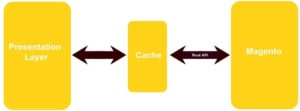“Headless commerce” is where the front-end and back-end of a commerce platform are de-coupled and stand independently of one another, separating the content presentation layer and the business logic/functional layer.

Satish Chavan
Why headless is becoming more popular?
There are two major factors. First, when e-commerce first entered the market, the majority of traffic to websites came from desktop. As a result, the solutions that sprung up at the time were full-stack which was all-inclusive with the website front-end and back-end coupled.
However, as technology evolved, the path to purchase expanded to include not only mobile traffic but a complex matrix of buyer touchpoints that demand flexibility, which is difficult for full-stack solutions to execute because the front-end and back-end of the system are coupled.
Secondly, every market player now wants to expand into commerce. Because of the amount of content that already exists, from an implementation standpoint it is much easier to build a commerce engine and connect it to the existing content management solution, rather than building a completely new website and having to migrate their old content into it.
What are the benefits of headless?
Flexibility
As the front-end and back-end of a headless system are decoupled, it is possible to make updates to the content layer without disrupting the business. For example, your marketing team wants to launch a new promotional campaign without having to rely on developers and a full system reconfiguration. This can be easily achieved through headless e-commerce implementation.
By decoupling the front-end and the back-end, headless e-commerce allows for infinite flexibility and customization to make whatever modifications you want, and only requires a front-end developer. Changes as big as making a custom checkout flow and as small as adding a new field to a customer account are easy when having a decoupled architecture. Also, the marketing team can run any promotion campaign at any time and update content/banners for these promotions on its own without having to rely on the IT team for the support.
Personalization
Because headless systems are de-coupled, they allow you to experiment without fear of slowing your website. For example, marketers could run continuous back-end experiments for achieving the highest level of user personalization without disrupting shoppers who are using the front-end search function.
With this integration, businesses can now look forward to a powerful and engaging e-commerce site. This includes personalizing the content based on demography (gender, geo-location, age, etc.), and educating and motivating customers while they are on the site via product showcasing, blogs or vlogs, images, etc.
The headless approach is available through such e-commerce platforms as Amla Commerce, Commercetools, Elastic Path, Four51, Magento and Salesforce Commerce Cloud.
When using a headless strategy on the Magento e-commerce platform, for example, content will be managed in a more user-friendly and advanced way than under Magento’s usual way of doing that in a single editor. Content will be displayed in a way that there is no or minimal overhead in terms of server and database resources on the Magento Store. The presentation layer can be easily scaled. Its secure platform will help in scaling it further in the future and will also reduce the risk of a security breach.
Speed
A decoupled architecture allows you to make rapid changes without disturbing the back-end, and vice versa. It also means new functionalities and integrations can be applied with much less time, because of the openness of the architecture. For example, you can make a quick update for customer-facing content without having to reboot your entire system.
As these are decoupled systems, the presentation layer talks with application layer through APIs. With this approach, you can build a data cache layer sandwiched between presentation and application layer. All catalog or static content requests can be cached at the cache layer. This way speed of content loading will be much faster and the system will able to support more traffic as compared with a full-stack application.

“Headless commerce” is where the front-end and back-end of a commerce platform are de-coupled and stand independently of one another, separating the content presentation layer and the business logic/functional layer.
Customization
With headless architecture’s decoupled approach to integrations, you can work closely with your technology team to identify which integrations make the most sense for your business that will actually impact your financial bottom line.
Customization and integration of other systems are much easier with this kind of architecture. As these architecture integrations are no longer a package deal, you don’t have to buy them in bulk.
And while the front-end and back-end are two independent systems, customization can be done in parallel.
In summary, apart from saving cost, going headless by decoupling a website’s back-end and front-end allows for quicker integrations, greater experimentation, personalization and speed.
Satish Chavan is president of e-Zest Solutions Inc., the U.S. unit of India-based e-Zest Solutions Ltd., an IT services company specializing in digital commerce, marketing and related technology and services. Follow him on Twitter @satishchavan.
Favorite